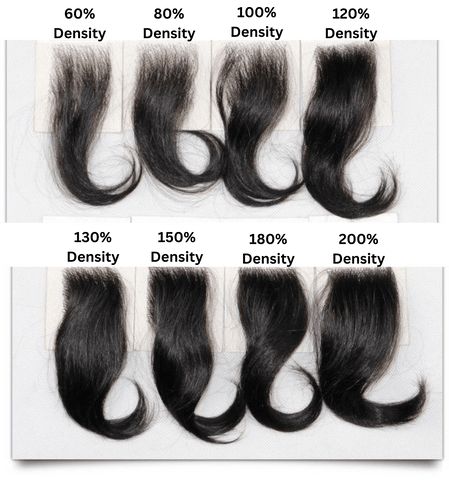Density Chart
Density refers to how much hair is used on your cap to create fullness. It is important to note that the perception of density is affected by the type of hair used and how it is styled (e.g. rollers and hair spray create the illusion of fullness). Curly, wavy and poofy textured hair expands when combed out, when the hair is separated and combed it looks fuller. Therefore two wigs with the same exact hair density can look different based on the way it is styled and its hair texture. For a natural look we recommend choosing a density that is close to your own. Medium density is the average choice. It is generally better to have more hair than less because you can always thin it out. You will also have more hair to accommodate for normal shedding from daily grooming. Lighter density units need repairs more quickly for this reason- this is why we do not recommend densities less than 100%.
A full lace wig is a wig made with human hair hand tied to a lace base. Full lace wigs are the newest innovation in non-surgical hair replacement systems. The hair is knotted into the lace and has the illusion as though growing from the scalp. Full lace wigs have been worn by celebrities for years but are recently becoming known to the general public. While customising your full lace or lace front wig it is very important to choose the right density to allow for the most natural look.
Hair density refers to how thick the hair is. The hair density that you order is really based on personal choice and what looks best on you. Most women achieve a natural appearance with light to medium or medium density; however your choice will depend on your styling preferences and individual profile.
Naturally growing hair grows differently for every person. Hair can grow thin (light) around the perimeter (hairline) and thick (medium) in the middle. Hair can also grow thick (medium) around the perimeter (hairline) and thickest (heavy) in the middle. Below are the most popular choices for densities in the lace front/ and full lace wig industry.

Light Density: This density is 60% thickness of an average head of hair. It is recommended for people whose natural hair does not have much volume or thickness. Light density on a lace front or full lace wig shows a fair amount of scalp. This density is popular with elderly women.
Light to Medium: This density is 130% thickness which is an average head of hair. This is the most popular density for full lace wigs. It means that full lace wig will have light density at the hairline and medium density every where else. This is the most natural looking and most recommended by top stylists. This density is suitable for most women.
Heavy: This density is 150% thickness of an average head of hair. We recommend this density if you would like a fuller look but would still like the unit to look natural.
Extra: This density is 180%-200% thickness of an average head of hair. This is too much hair for most women to look natural. This density in lace front wigs or full lace wigs is usually worn by performers who desire a heavy style. Not recommended for someone looking for a natural look in a full lace wig.
Remember whatever density that you choose full lace wigs provide the most natural looking extensions in the market today.

